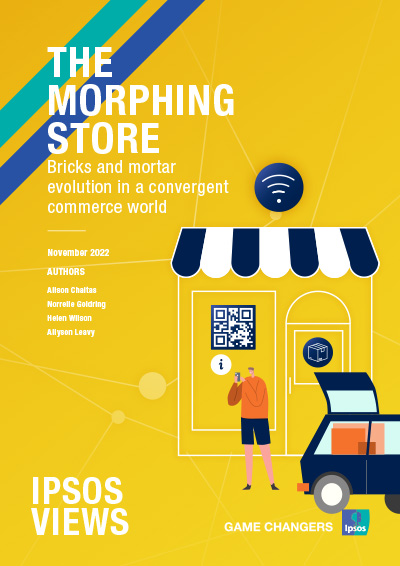The Morphing Store: bricks and mortar evolution in a convergent commerce world
 Whilst the pandemic opened the digital commerce floodgates, there has been a return to physical store shopping as the pandemic eases.
Whilst the pandemic opened the digital commerce floodgates, there has been a return to physical store shopping as the pandemic eases.
Ipsos data is indicating that the supposed death of the bricks and mortar store has been greatly exaggerated. Shoppers are spending a significant portion of their shopping time – between 39% and 73% (depending on the category) shopping in the physical store. Between 29% and 77% of purchases are subsequently made in-store.
The changing nature of commerce is pushing the physical store to adapt and reassess. Traditionally, the role of the store has been to offer a place to display products and allow consumers to explore, interact, and purchase. However, we’re seeing an increase in the functional, experiential, and human aspects of the store – for instances, expansions in delivery fulfilment, showrooms, or face-to-face connections.
As the role of the store evolves, so do the channels around commerce. The physical and digital environments are blurring, channels will no longer be competing but rather working together. There’s a need for CX Service Design to design and deliver end-to-end experiences, that fulfil the functional and emotional needs of the customer; to create that emotional attachment which will drive increased acquisition of customers, retention, share of spend and advocacy – in an operationally efficient fashion, which will deliver the ultimate goal of ROCXI (Return on CX Investment).
This fluidity, where shoppers move between channels and experiences, whether online or offline, means that retailers need to think about how the physical store can support and incorporate digital commerce channels, and vice versa.
The expanded role of the physical store means the expanded need for metrics and success measures to match the store’s new roles and objectives, with the likes of Voice of the Customer, Execution Measurement and Mystery Shopping research all playing a role.
5 key takeaways
- Death of the physical store has been greatly exaggerated
Physical stores are expanding with roles going beyond simply transactional – changes from functional, logistical to experiential. - The experiential imperative is at the centre of the physical store
Digital experience is limited; there’s an opportunity for stores to leverage in person experiences through all the senses. - Convergent commerce is fluid with collaborative channels
Commerce channels are no longer competing but merging and stores need to readjust to meet new consumer needs. - Changing roles means changing metrics
No longer about sales per square foot, so how does the physical store pay for itself when they become more experiential? Ipsos’ Return on CX Investment (ROCXI) can demonstrate the financial impact of physical stores. - As the commerce model changes, new challenges will arise
With any shift in industry there will be hurdles to overcome. How will physical stores pay for themselves? What form will stores take as needs change? How has the pandemic changed people’s behaviour? How does a business build a consistent and emotionally engaging end-to-end experience for consumers?
To find out more about commerce and the changing nature of the physical store, read The Morphing Store: bricks and mortar evolution in a convergent commerce world.



![[LinkedIn Live] Ipsos Global Trends: The Workplace Edition](/sites/default/files/styles/list_item_image/public/ct/event/2024-11/ipsos-global-trends-workplace-edition-thumb.jpg?itok=wucV_Pn4)